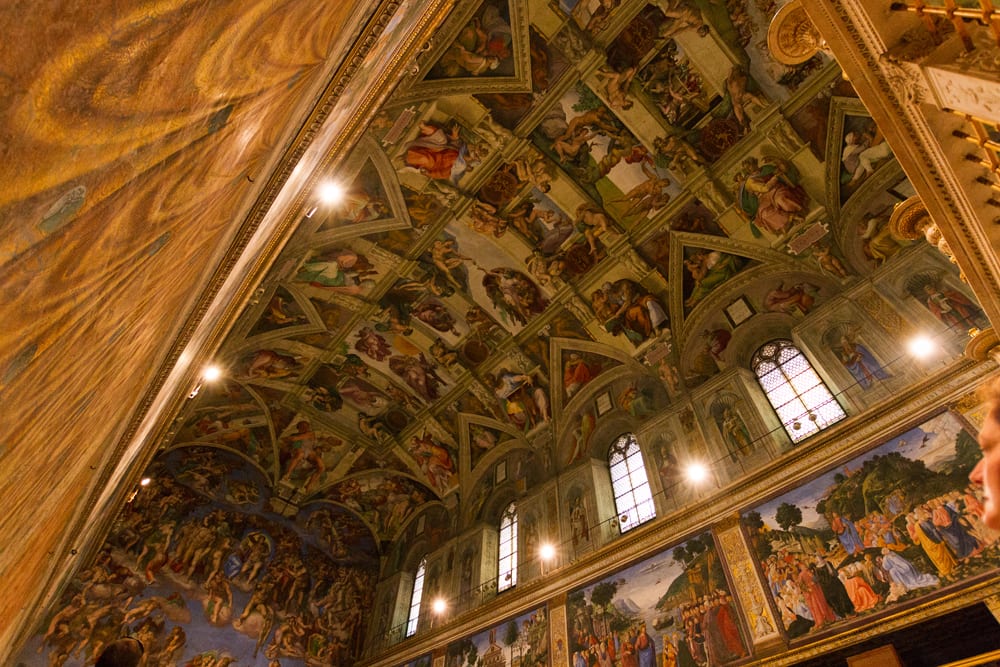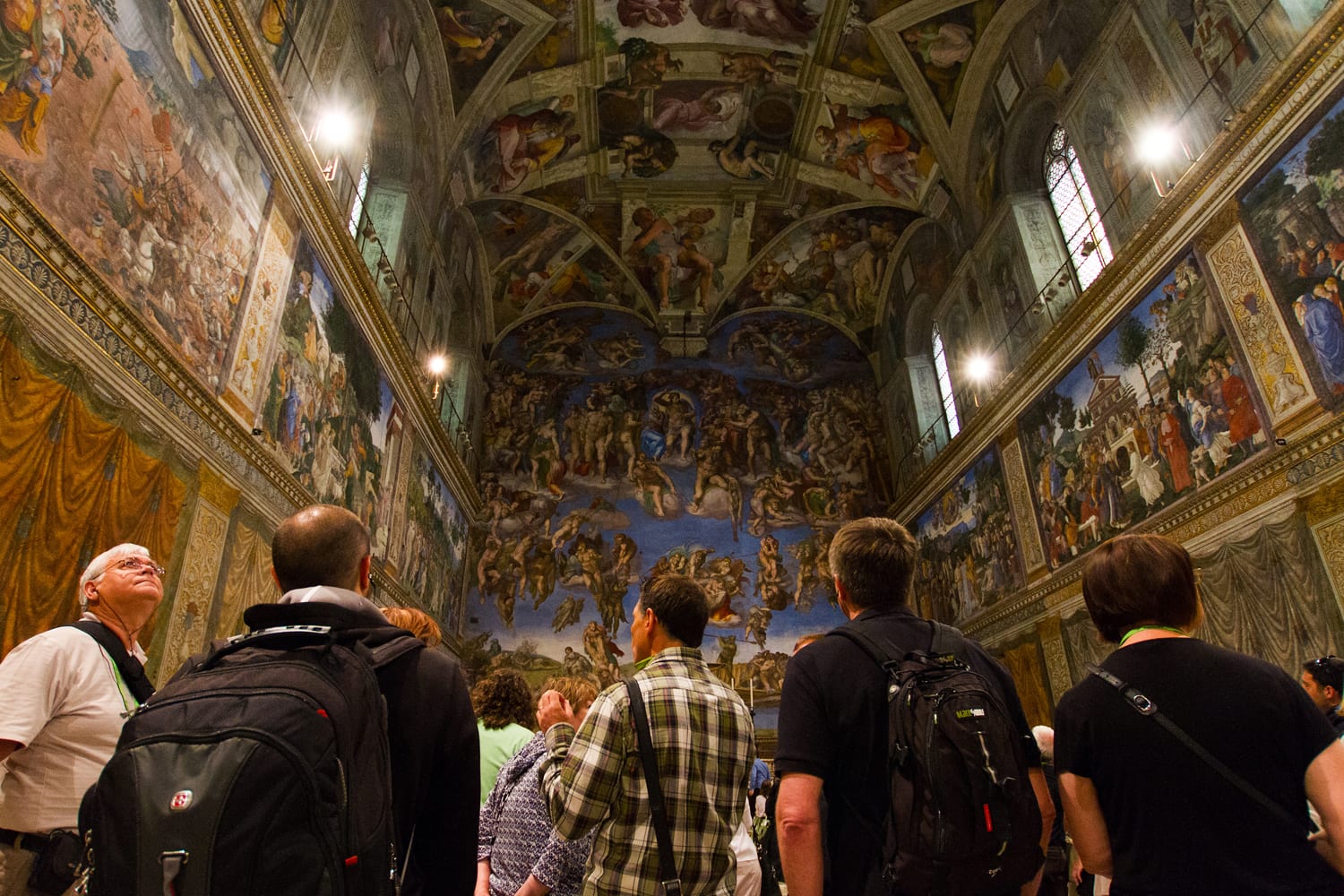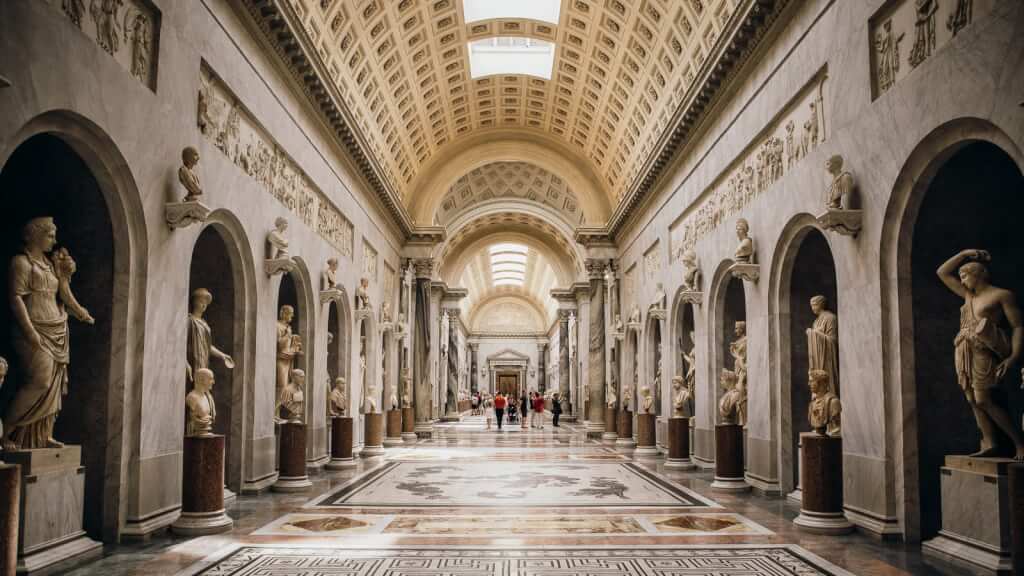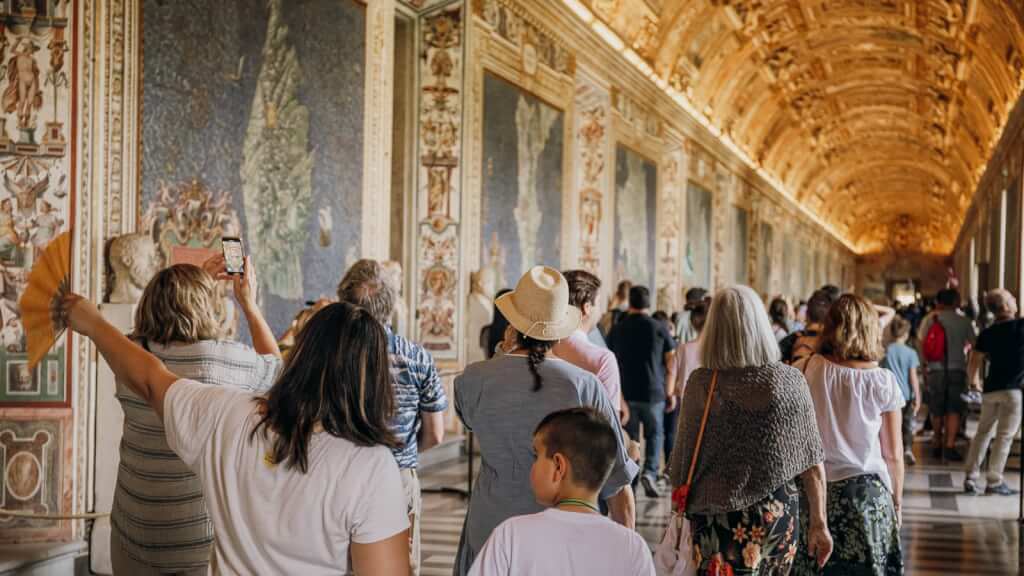
The Sistine Chapel in the Vatican Museums: Best Tips for Visiting
November 13, 2024
Among the most famous rooms in the world, the Sistine Chapel stands alone. Neither one of the largest nor grandest properties in the Vatican, its fame is mostly based on its immense ceiling frescoes created by none other than the great Michelangelo Buonarroti.
This series of scenes from the New Testament of the Bible form a staggering tableau that the art critic Robert Hughes once described as “…the most powerful – if not in all ways the most likeable or even comprehensible – series of images of the human figure in the whole history of European art.”

Under these are wall frescoes by an all-star lineup of quattrocento artists likes Sandro Botticelli and Luca Signorelli, as well as the enormous altar-wall fresco, The Last Judgement, which Michelangelo painted some 20 years later. Taken together you have probably the most awe-inspiring collection of western art that exists within four walls.
It’s no exaggeration to say that visiting the Sistine Chapel is one of the must-do experiences in Rome. Although crowds have become the norm in this Vatican attraction, there are still ways to visit without the tourist hordes blocking your view. For a more exclusive visit why not try our Pristine Sistine™ tour, which lets you into the chapel before the general public, or our VIP Vatican Key Master’s Tour: Unlock the Sistine Chapel where you’ll have the Vatican Museums to yourself for two full hours as you enter with Key Master before dawn.
Table of Contents
ToggleVisiting the Sistine Chapel: What to see
The Ceiling Frescoes
When Michelangelo received the commission to paint the ceiling of the Sistine Chapel in 1508 he was not stepping into an unmarked space. The chapel had been built some 30 years before by the now mostly forgotten architect Giovannino de’ Dolci during the the reign of Pope Sixtus IV – for whom it’s named (it is not called the Sixteenth Chapel, as the common misnomer states).
Sixtus had the space’s walls frescoed by some of the greatest artists of the day, including Sandro Boticelli, who is now more famous for his paintings, The Birth of Venus and Primavera, and Pinturicchio whose work is on display in other parts of the Vatican.
The ceiling, however, was blank except for a coat of ultramarine blue with golden stars at regular intervals. And what a ceiling: 10,000 square feet of it needed to be frescoed, and unlike contemporaries like Raphael, Michelangelo did not employ assistants to finish paintings that he had planned and started. Instead, he lay on a scaffolding from somewhere between three and four years and painted it himself.

This is even more astonishing when you consider that it isn’t a painting, in which oil paints are applied to dry plaster. Frescoes must be painted onto fresh, (read: damp) plaster, which means that once a section was started, it had to be completed that day. Thus the entire wall had to be painted as a jigsaw puzzle – piece by agonizing piece.
Michelangelo reportedly hated it and had no qualms about telling anyone who would listen, including a humorous sonnet that he wrote to a friend in which he claims that the work has given him a goiter: “the kind wet cats get in the Lombard swamps.” Regardless of what the work may have done to Michelangelo, the nine scenes he created were nothing short of sublime.
From the Separation of Light from Darkness all way through the Drunkenness of Noah, he casts the spectator into the midst of the creation of life according to the Bible. The work’s scale and mastery dwarf the humans staring up at it, filling the entire chapel with a hushed sense of awe and a palpable impression of the divine. Whether it is artistic divinity or religious divinity is up to the spectator to decide.
The Last Judgement
Michelangelo’s other great addition to the Sistine Chapel is the colossal Last Judgement, painted on the altar wall that rises up behind you as you enter the chapel. If the ceiling is concerned with the origins of life, the Last Judgement paints a none-too-rosy picture about where it’s going.

It shows the second coming of Christ as he lays divine judgement on a who’s who of biblical characters. Painted some 20 years after the ceiling, when Michelangelo was 66, it is a dark and troubling work. While its depictions of the human body are considered second to none, its tone of damnation and divine retribution often feels more oppressive than uplifting. Why this should be remains a matter of debate among art historians.
Although many point to the sacking of Rome in 1527, which effectively ended the High Renaissance, details like the flayed skin in the hand of St. Bartholomew, appearing to be a depiction of Michelangelo himself, point to perhaps a more personal reason as well. Whatever the case, the The Last Judgement is as unsettling as the ceiling is awe-inspiring, and a work that needs to be seen in person to experience its full force.
The “Other” Frescoes
Few go to the Sistine Chapel to see anything but the works of Michelangelo. However, we would be remiss if we didn’t mention the frescoes that adorn the other three walls and would hold pride of place if they happened to be located almost anywhere else in the world.
Pietro Perugino, Sandro Boticelli, Cosimo Rosselli, Luca Signorelli, and Pinturicchio all have masterworks here. When you visit the Sistine Chapel do yourself a favor and take your eyes away from Michelangelo’s work for a few moments and admire the other walls. You won’t be disappointed.
Tips For Visiting the Sistine Chapel
Measures are presently in place to ensure visits can take place in the best and safest conditions, and prevail over the ordinary conditions. Entry to the Vatican Museums is by obligatory online booking.
Opening Times:
From July 1, 2021
Monday to Thursday: 8.30am to 6.30pm with last entry at 4.30pm
Friday and Saturday: 8.30am to 10.30pm with last entry 8.30pm
Visitors are required to leave the halls 30 minutes before museum closing time.
A small number of tour groups, like our Pristine Sistine tour, are allowed inside before the Vatican opens to the public each day. For the most exclusive Vatican imaginable, join our VIP Vatican Key Master’s Tour: Unlock the Sistine Chapel, where you enter before dawn and travel with the Key Master as he unlocks silent rooms and galleries.

Closures
The extraordinary openings on the last Sunday of the month are suspended.
Closed: Sundays, 25th and 26th of December (Christmas and St. Stephen’s Day) ; January 1, 6; February 11, 22; March 19, 28; June 29 (the Feasts of St. Peter and Paul); August 15; November 1; December 8.
Check the Vatican website for more information on holiday closings and special openings.
Rules for visiting the Vatican Museums
The rules of the Vatican are strict and pretty uncompromising – please familiarise yourself with them before attempting to visit.
The Sistine Chapel is a holy place – as such both men and women should be sure to wear clothes that cover their shoulders and knees. Occasionally, visitors get away with wearing a bit less but it’s best not to risk it. Hats are also not allowed.
Although most of the Vatican Museums has no rules about noise, it is prohibited to speak in anything above a whisper in the Sistine Chapel. This is because the large number of people that visit the chapel every day would make it almost impossible to enjoy if everyone were speaking at once. Selfie sticks are forbidden for much the same reason.
All photography is strictly prohibited in the Sistine Chapel. The guards won’t confiscate your camera, but they will make you delete your pictures or even take your film if you are shooting on analogue.
You cannot bring any bag, backpack suitcase or container larger than 40cm x 35cm x 15cm into the Vatican Museums. Similarly, you can’t enter with medium to large umbrellas, any umbrellas with spiked tips, camera tripods, signage (apart from signs used by certified guides) or walking sticks – except those required by disabled visitors. All of these items can be left in the cloakroom.
Firearms are strictly prohibited for visitors within the Vatican and cannot be checked in the Cloakroom. Knives, scissors and other cutting tools are permitted but must be deposited in the cloakroom as as a precaution against harming the artwork inside.
The Vatican Museums are under constant video surveillance and any touching or tampering with artwork is strictly prohibited. Also, no laser pointers.
You aren’t allowed to bring food or drink into the Vatican Museums. You can, however, leave them in the cloakroom and collect them at the end of your visit. Any food or drink that goes uncollected will be disposed of at the end of each day.
Tickets
In order to get a reduced ticket fare you must have valid ID upon ticket purchase or collection (in the cast of pre-purchased tickets or tours).

Best Time to Visit
May through September are usually considered the high season in Rome, with a mini high season around Easter. As one of the must-see attractions when in Rome, you can still expect a crowd inside the Vatican nearly any day of the week.
The best way to work around this, regardless of the time of year, is to visit the Sistine Chapel before it opens to the general public. The only way to do this is through select tour groups. If you want to go it alone, you can still avoid some of the hordes by visiting when it first opens. If you aren’t concerned with spending a lot of time in the Museums, you can go later but remember that visitors are required to leave the halls 30 minutes before museum closing time.
Getting there
The best way to reach the Vatican Museums is by taxi or Metro
If traveling by taxi, make sure to specify to the driver that you are going to the entrance of the Musei Vaticani (Vatican Museums) NOT the entrance to St. Peter’s, which is a 15-minute walk away.
If traveling by metro, take the Metro A line to the Ottaviano stop. As you leave the exit, hang a left down Via Candia and turn left at Via Tunisi. At the end of the street there is a set of steps; climb them and cross the road and you’ll be at the entrance to the Vatican Museums.
Remember: Unless you are traveling with a guided tour that includes St. Peter’s Basilica, the church isn’t accessible from the Museums. If you want to visit it you will have to exit the Museums, turn right, and follow the wall around to the entrance of St. Peter’s. It’s about a 15-minute walk.
by Martina V.
View more by Martina ›Book a Tour

Pristine Sistine - The Chapel at its Best
€89
1794 reviews

Premium Colosseum Tour with Roman Forum Palatine Hill
€56
850 reviews

Pasta-Making Class: Cook, Dine Drink Wine with a Local Chef
€64
121 reviews

Crypts, Bones Catacombs: Underground Tour of Rome
€69
401 reviews

VIP Doge's Palace Secret Passages Tour
€79
18 reviews

Legendary Venice: St. Mark's Basilica, Terrace Doge's Palace
€69
286 reviews









